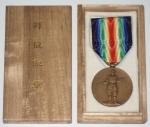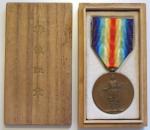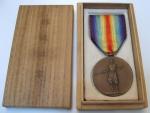-
Posts
1,751 -
Joined
-
Last visited
-
Days Won
3
Content Type
Profiles
Forums
Blogs
Gallery
Events
Store
Everything posted by Dieter3
-
Ha! Yeah, I sleep about 6 hours a night fig I'm lucky! ;)
-
Well, I was right - it was a more modern piece, obviously post-war, but I might have lost that wager on not being the most recent type! Did this come with a rosette, or pin? This is probably of the most recent style of manufacture, could very well be into the 90s.
-
Looks like a more modern piece, post-war, but when specifically? Not sure, but I'd wager it was not the most recently made version. O.K., surprise me!!! :lol:
-
Another one to throw in, but it doesn't change the time period - but confirms at least 1935 probably 1936 too - the Pu Yi Visit to Japan medal - made by Osaka, and with the "M" hallmark.
-
Got one of those: And they are more different - this gold one would of course be post-1956 (I'm guessing 1960s) - I believe these to be transitional pieces between the original Order of Merit that started the thread and what finally became the modern pieces we know - you will also find these lacquer-cased medals with the kanji for silver that distinguish them from the former "Order of Merit" that had no distinction of silver or gold - why we know it at least predates 1956 - but by how much - that is the mystery!
-
Where is that exactly, in a shop? Looks like it is sitting on top of a display case.
-
Very Nice!! A rare thing!
-
I'd do it!! :lol:
-

VERY odd japanese shell...or ? WHAT IS THIS THING?
Dieter3 replied to grimble-nibitz's topic in Japan
Go here, pose the question: http://forums.gunboards.com/forumdisplay.php?52-Firearms-Of-The-Rising-Sun -
Actually, yes!! Now, I don't how many special contributions or meritorious acts a person must make or do, but this was also a way to receive the honor, other than pure financial contribution. Unfortunately, I have no first hand information of exactly what any of these things might have been!
-
No, but my point being that government or civilian situation - the labor and resource situation was an issue (impacting quality and so on across the board). I don't know if Red Cross medals were awarded or not during the occupation - as they were not government awards. I'm sure literature will have this information but I haven't searched for this. Unfortunately, all of the Red Cross employees/volunteers that I have dealt with simply have no clue whatsoever about medals, so I must rely on literature, most of which I don't have!! Only bits and pieces. Plus - times were very hard for civilians and these awards took considerable cost or contribution - and I think many people didn't have the money to contribute - so there are very few of these awards as a result. Another theory.....too many theories, huh? Well, I just don't know on the box as far as materials are concerned - I'm guessing it was easy to make a simple mold for the Bakelite and then finishing it would not be too hard along the exposed surfaces. I think it would be easier than making the lacquer box since it was wood of many pieces that had to be precision cut, assembled, prepared, and then lacquered and finished with nicer hardware. It seems more skill and time would be needed to make the lacquerware case and perhaps these artisans were employed to work in weapons factories or simply abandoned their practices altogether, perhaps they were destroyed because of bombing, who knows? I think maybe we will simply never know. But we must define "war-era" - what would you say? I think we all agree it would be World War II - but what years specifically? From the China Incident to 1945? Post-Pearl Harbor? I think I agree with you - when things started to really turn badly for the Japanese 1942-1945 would certainly be a possibility of the time frame for this piece, but I might extend that up to say 1950.
-
Well, these are not at all rare. Given that it is a medallion only, in the condition photographed, maybe $40.00-$50.00 U.S. These medals complete with case and all in really goo condition usually go for between $100-$150.00 U.S. But I have learned that prices are a very subjective matter, and I have learned not to question the motives of buyers and why sometimes well beyond the average price is achieved for a given piece!
-
The quality of many articles produced in the mediate post-war period in Japan was not the highest. This carried even into the 60s and 70s when some Japanese cars were being imported into the U.S. - they were noted for their rather poor quality. Of course this improved! But many families were extremely hard up for many years following the war - hence - not peaches and cream - times were tough, I know first-hand from relatives about this period, both Japanese in-laws as well as blood relatives visiting Japan in the 50s. The one thing we DO know is that this pre-dates 1956, it is NOT post-1956. An early box it is not - earlier boxes were of lacquer or paulownia wood, this one is not, a portion of it is definitely Bakelite. Late it is not - late cases are very obvious, the black ones with the pebbled exterior, some sort of coating over a metal shell. Handmade by an individual? Probably not. Made by a shop? Quite possible. You must take into account the features of this medal as compared to other medals that are encountered, not only meritorious awards! Yes, a bit of guessing is involved, but I'd call it at least semi-educated.... It is a bit of a mystery - but that's what makes this fun!!
-
There is a Sale Room on this forum, but eBay of course!
-

Japanese Victory Medals
Dieter3 replied to Tim B's topic in Inter-Allied Victory Medals of the Great War
Here are the three examples in my collection, all vary somewhat in the ribbons, with minor differences in the medallions (hard to see in these small pics., sorry!) The green stripes in the first one are so bright - the ribbon is correct, but possibly a replacement, just not sure. http://gmic.co.uk/uploads/monthly_10_2011/post-6375-0-22302700-1317530165.jpghttp://gmic.co.uk/uploads/monthly_10_2011/post-6375-0-71156500-1317530174.jpghttp://gmic.co.uk/uploads/monthly_10_2011/post-6375-0-27514700-1317530183.jpg -

Japanese Victory Medals
Dieter3 replied to Tim B's topic in Inter-Allied Victory Medals of the Great War
I have in my records from observations the following high numbers on certificates - 1914-15 War - 133,571 (not as high as Paul's 136,512) 1914-20 War - 346,397 WWI Victory - 206,904 Paul's theory could still be correct in that only 1914-15 medal recipients received the WWI Victory medal as well. Given the frequency of these medals, I'd expect to see numbers on certificates in the 300-400K range had there been that many issued. Seems a little odd that they don't appear otherwise. -
NO - not with Red Cross anyway. I think the characters range from year X to year Y - but no idea what the range is, how big or small. I think maybe 1920s - 1940s. Just a guess!! Not exactly - but some of these marks do occur within time periods it seems - not specific years. I agree! I believe marks were used by makers - we know this is true with the "N", "S", "M", "Y" marks found on the Showa Enthronement Medal - the wrapping papers indicate the company that made them, and the marks always seem to correspond accordingly. Red Cross medals can also be found with the "S" - I wonder if it is the same company that made the Showa medal?
-
The mark must have been used for only a very limited time (like you said 1929 start) - most orders do not have the mark, even though they were made by Osaka so the period of use was a very few years I believe. My thinking is that at the time of the scandal and shortly after, Osaka wanted the authenticity to be known - but after a few years, because everything was made by Osaka, they dropped the M. Just a thought - but of course, without it, how can they guarantee authenticity? Of court, not hard to copy an M stamp!! But why don't all of the orders have this mark otherwise? Something else that is interesting that I have noticed is that the rosettes of a certain period also have the mark "ス" on them, maybe around a similar time? What do you think of this?
-
Yes, I do not know for how long these were in use, but you can find them with the Orders that come in the lacquer cases and the black, "modern" cases - however they are typically the earlier ones of these (they are not as tall, have the thinner kanji style, not the really bold style). When exactly these cases were started I do not know, 70s? 80s? But at some point, the full button came back, and then the modern all-metal pin, maybe 80s, or 90s? You are right though - the orders are still of top-quality no matter the period - they do not seem to have cut corners on those! - BUT I would offer that there are probably very few of these from the war period for financial reasons and personal circumstances, but just a guess.
-
Ah!! But you will see differences in the hooks and catches on later awards that never occurred on earlier ones unless they were replacements - look at the styling of the C and D pieces. They are different! I think the "M" was used for a certain period when several makers made medals, then the scandal occurred, then the "M" became somewhat unnecessary since all medals would be made by Osaka. Does that seem possible?
-
No, no, not at all! You are not a pain in the neck! This is a great discussion! We do have direct evidence for at least this style of rosette and attachment pin on the medal occuring after the war - you will see the same designs used in both silver and gold merit medals and special members medals, and lifetime member's medals. It's very obvious because these were in cases with kanji for silver and gold (other than the life member of course!) and we know this happened after 1956 - this is good evidence! The bad evidence is was this applied at all during the war? Probably.
-
I agree with your classifications and you are right - the only way to be sure on these 100% would be to get infer from the Osaka Mint (SOMEBODY must know something!!) or to have the actual medals with real documents as awarded to individuals with no tampering! This is a challenge of course. Your Variation D though is easy - we know when these medals began production, so we know when Variation C ended. Of this we can be sure, but only this for now. But let's not forget the other parts of the medal - look at the hooks and catches - these change too and seem to evolve in the Sacred Treasure and the Rising Sun Orders. Variation B needs to be examined closely for these features and checked against others for distinct similarities or differences. ALSO - I forgot about this - Variation C Sacred Treasures have maker codes on the suspension ball - these were later moved to the back of the paulownia suspension on D - so I believe we know C is more modern buy this as well. I do not have a variant B, so I don't know if they have similar codes.....???
-
GORGEOUS!!!!! :beer:
-
Hi Nick, So the point of the clasp being that because they were used in what I believe to be the first of the silver and gold orders after 1956 use a very similar clasp - this particular piece could have been a transitional one - I'm trying to piece together the evolution (if that is really possible!!) It is also possible that the case was produced by a workshop - many of the lacquer cases were produced by independent lacquer-ware makers, I assume contracted by the Red Cross, but I do know for certain. So the idea is plausible. No, 1956 wasn't 1946, but it wasn't peaches and cream either! The Red Cross made changes to the various medals over time as we can tell, but with specificity to 1956 - this is actually found in Red Cross literature - this was when the simple Special Membership was changed to Silver and Gold Special Membership and Order of Merit became the Silver and Gold Orders. So prior to 1956, there were no gold medals - the merit award was simply Yuukoushou as the kanji indicate, merit award. With regards to the attachments - the pins - before the war and then in modern awards these medals used a safety pin attachment for the medal and the rosettes were quite often buttons with the black disc base as we are familiar with - 2 things - these are more complicated to make, and use more raw material, cost more. So in pressing times as is war, everybody in manufacturing had to simplify and save where they could. Apparently, they were not willing to sacrifice the actual quality of the medal itself, not for the Order. We do know though that others suffered as they were made from aluminum. More modern pieces re-adopted the more complex safety pin attachment and the black base button, that eventually became the modern all-metal cross pin. These Orders are harder to examine and find, but look at the Special Members medal - the pre-war ones at some point adopted a safety pin, I don't know when specifically, perhaps in the 1930s. So yes, these are totally normal, nothing odd about them - but they are simplified forms - why? Well, these are only my theories here - I'm trying to put the pieces of the puzzle together!!!
-
Whenever in doubt, simply state that in any transaction! :)





